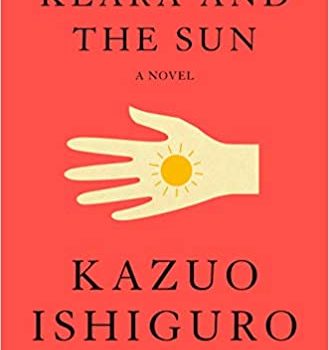Ian Mond Reviews Klara and the Sun by Kazuo Ishiguro
 Klara and the Sun, Kazuo Ishiguro (Knopf 978-0-59331-817-1, $28.00, 320pp, hc) March 2021.
Klara and the Sun, Kazuo Ishiguro (Knopf 978-0-59331-817-1, $28.00, 320pp, hc) March 2021.
Over the last couple of years, it’s been surprising to see literary authors of the calibre of Jeanette Winterson and Ian McEwan, with their respective novels Frankissstein (which I reviewed in 2019) and Machines Like Me, raise concerns about machine consciousness. Compared to climate change, pandemics, or the fallout from late-stage capitalism, the robot-apocalypse is not something that keeps me up at night. Yet Winterson and McEwan have argued that, as a society, we’ve underestimated the ethical and social implications of manufacturing a whole new species. To quote Winterson: “We’re going to share the planet with a self-created non-biological lifeform smarter than we are! Well done, human race!” Their voices have now been joined by Nobel Prize laureate Kazuo Ishiguro, who deliberately did not read either Frankissstein or Machines Like Me, but whose eighth novel, Klara and the Sun, portrays a future where the class divide is further widened by artificial consciousness and genetic splicing.
Ishiguro initially conceived the novel as his first children’s book, and vestiges of that remain in the child-like innocence of Klara. She is an AF (Artificial Friend), wide-eyed and innocent, who spends her days in a store, alongside other AFs, waiting to be purchased as a companion for a boy or girl. All the AFs look forward to the day when they’re given the “special honour” by the Manager to stand by the window and represent the store to the outside world. Not only does it improve their chances of being sold, but it also means the AF can bathe in the nourishment provided by the sun (they are powered by solar energy). For Klara, there is an added incentive. As she informs us, “unlike most AFs… I’d always longed to see more of the outside – and to see it in all its detail.” It’s during her period by the window that Klara observes the dreaded Cootings Machine, pouring its pollution into the sky, which will play a pivotal role in the unfurling of the plot. It’s also where she first encounters Josie (“I saw you, and I thought that’s her, the AF I’ve been looking for!”), who excites the automaton with a promise of a view from the teenagers’ bedroom window where “you can see exactly where the Sun goes down.”
Told exclusively from Klara’s limited perspective, we get the impression that the novel takes place somewhere in the United States at a point in the future where society is on the verge of collapse. We get a fleeting impression of this from Josie’s estranged father, who lives in a community that faces constant threat from “gangs and guns.” Josie, however, enjoys a privileged and peaceful lifestyle – a large home, surrounded by farmland – with her mother Chrissie, her housekeeper Melania, and now, of course, Klara.
Josie’s closest neighbour is her best friend Rick, who lives with his eccentric mother in a ramshackle house up the road. It’s with the introduction of Rick that we begin to appreciate the role genetic splicing plays in Ishiguro’s near future. Josie, just like other kids from affluent families, has undergone a process called “uplift,” the genetic tinkering of her DNA to enhance her intelligence. In contrast, Rick has not been uplifted. This means that regardless of his natural intelligence, a knack with drones and a skill with words, he will not be permitted to attend College – higher learning is for uplifted kids only. But here’s the rub: uplift is not risk-free. Josie’s older sister, Sal, died from the procedure and Josie, to the horror of her mother Chrissie, is exhibiting similar symptoms.
Klara and the Sun is a novel about class, about the wealthy using technology to ensure their progeny survive the coming slow apocalypse. What emerges, though, is a powerful narrative of two mothers and the lengths they go to for the sake of their children. There’s Chrissie, who has never truly recovered from the death of Sal and yet feels she has no choice but to uplift Josie. In contrast, there’s Helen, Rick’s mother, who chooses not to uplift her son, knowing full well the impact this will have on his future. They are both complex, layered characters, sympathetic but difficult to like. I think of the queasy yet oh-so sad moment, where Chrissie asks Klara to mimic Josie, or the shocking revelation as to why Chrissie, initially resistant to AFs, decides to eventually purchase Klara. With Helen, there are numerous scenes where we see her at her most fragile, but the one that stands out is where she pleads with an old flame – a man in a position of power – to consider accepting Rick’s application to the one College that accepts non-lifted teens.
I was less in love with Ishiguro’s take on artificial intelligence. It’s not bad by any stretch. I did like Klara’s deification of the Sun, including her promise to slay the Cootings machine if the Sun intervened to save Josie’s life. But Klara’s observation of human interaction, especially the intimate bond between Josie and Rick (“I should observe him carefully to understand how he belonged within the pattern of Josie’s life”), isn’t something we haven’t seen many, many times before in genre fiction and popular media. I also found Ishiguro’s exploration of consciousness and whether it can be replicated (i.e. the long-standing debate between dualism and physicalism) to be half-hearted and unsatisfying. (With little justification or reasoning, Ishiguro lands on an ephemeral view of consciousness). But it’s Klara and the Sun‘s ending that I found most disappointing. I won’t provide details, but given the bleak nature of Ishiguro’s world, it’s overly sentimental and cloying. It’s a climax that almost, but not entirely, undermines the book’s most powerful and visceral moments, of two mothers going to great lengths to save their children from an uncertain future.
This review and more like it in the June 2021 issue of Locus.
 While you are here, please take a moment to support Locus with a one-time or recurring donation. We rely on reader donations to keep the magazine and site going, and would like to keep the site paywall free, but WE NEED YOUR FINANCIAL SUPPORT to continue quality coverage of the science fiction and fantasy field.
While you are here, please take a moment to support Locus with a one-time or recurring donation. We rely on reader donations to keep the magazine and site going, and would like to keep the site paywall free, but WE NEED YOUR FINANCIAL SUPPORT to continue quality coverage of the science fiction and fantasy field.
©Locus Magazine. Copyrighted material may not be republished without permission of LSFF.







